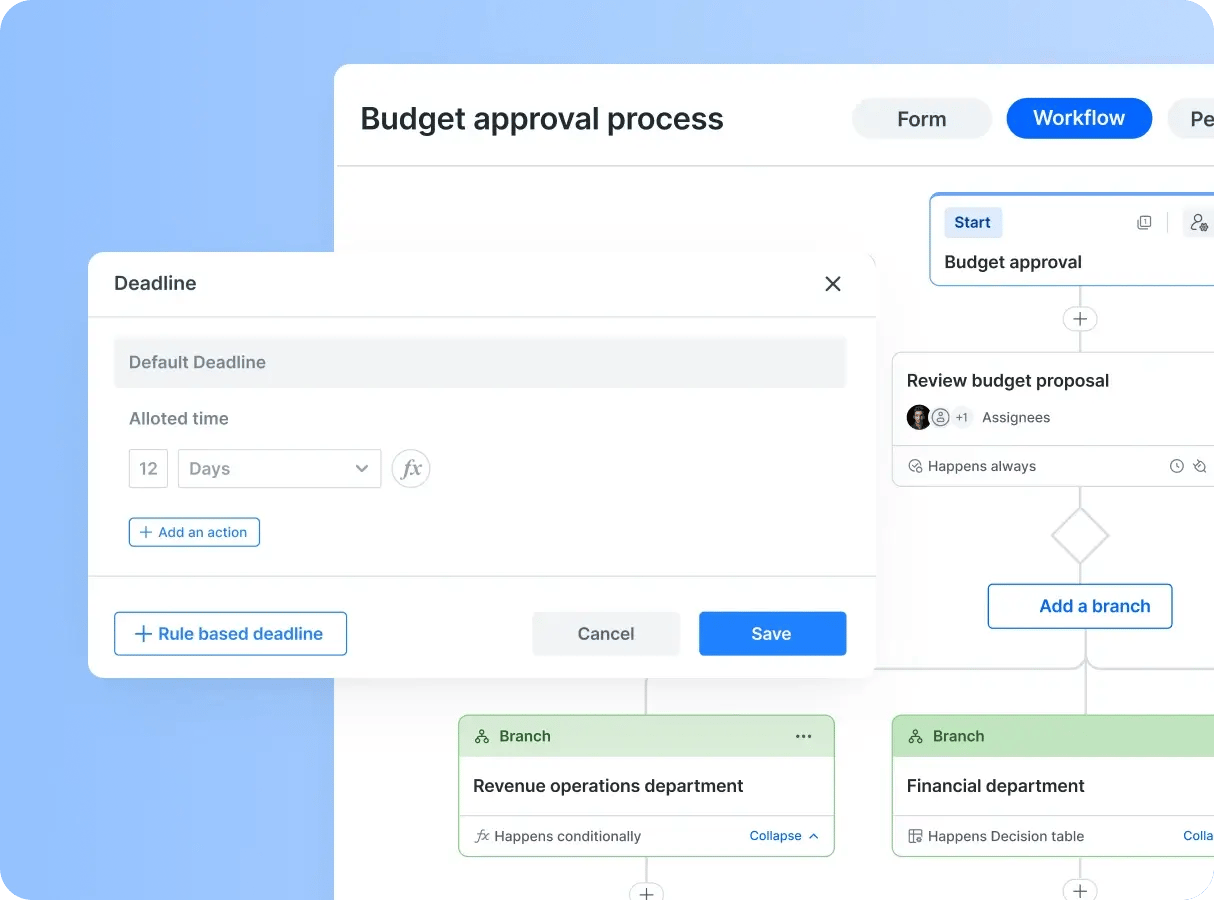Automated Timeline Control
Assign custom due dates, set escalation paths, and automate reminders based on your timelines.

Empower your teams to design and run workflows with custom workflow software - no coding, just drag, drop, and deploy.
.webp?width=2116&height=1890&name=Hero%20image%20(2).webp)



Most workflow automation software forces you into predefined templates that rarely
match your actual processes. Here's what happens when you're stuck with rigid tools:

You have to modify proven business processes to fit the software's limitations.
Teams create manual steps outside the system to handle unique requirements.
Each team needs different features, leading to multiple disconnected tools.
Can't connect with your existing systems the way your business actually operates.
Custom workflow software lets you build processes that match your organization’s unique needs. With full control over forms, approvals, notifications, and integrations, our workflow builder empowers you to create tailored workflows—without writing a single line of code.

With Kissflow's custom workflow software, you can tailor every aspect of your
business processes to your exact requirements. Build workflows with complete flexibility and control.





Invoice approvals with multi-level authorization, expense reimbursements with receipt validation, budget request workflows with cost center routing, and procurement processes with vendor compliance checks.
Employee onboarding with role-specific checklists, leave request approvals with coverage planning, performance review cycles with 360-degree feedback, and recruitment workflows with interview scheduling.
Help desk ticket routing with priority-based escalation, software deployment approvals with testing requirements, access request workflows with security clearances, and incident management with stakeholder notifications.
Lead qualification with scoring criteria, contract approval workflows with legal review, campaign approval processes with brand compliance, and customer onboarding with success metrics tracking.
Quality control checklists with corrective actions, maintenance request workflows with asset tracking, supplier evaluation processes with compliance scoring, and project approval workflows with resource allocation.
2M+
Annual transactions
on Kissflow
450%
ROI in just
2.8 months*
94.7%
Customer
Satisfaction score


One of our Finance Leads said, ‘This is so easy, even my mom could do this. It was extremely intuitive and straightforward.’ The watermark was, 'I don't need to call IT to do this. I can do it myself.
Renee Villarreal
Senior Director of IT
Industry
Energy
HeadQuaters
USA
Key Highlights
23,000+
work items processed
5,526
active users out of 6,000 licenses
132
active workflow created without IT dependency


The beauty of Kissflow is how quick and easy it is to create the apps I need. It's so user-friendly that I made exactly what I needed in 30 minutes.
Oliver Umehara
IT Manager
Industry
Telecom & Media
HeadQuaters
Japan
Key Highlights
30
minutes app development time
10-20
requests approved per day
10
minutes learning time

The Kissflow team met our expectations and helped make the transition smooth. The support personnel has been very helpful and always available when needed to help us to fix issues.
Nicholas Githinji
Group Processes Head
Industry
Manufacturing
HeadQuaters
Kenya
Key Highlights
30+
hours saved per week
35%-45%
reduction in process cycle time
2,500+
items processed
Creating custom workflows in Kissflow is simple: start by mapping your current process, then use our drag-and-drop designer to build your own workflow steps. Add forms, set approval rules, configure notifications, and integrate with your existing systems. Most workflows can be built in hours, not weeks.
Absolutely! Our no-code platform is designed for business users. With intuitive drag-and-drop tools, visual process designers, and pre-built templates, anyone can create and modify workflows without programming knowledge. We also provide training and support to ensure success.
Customizable workflow tools provide flexibility to match your exact processes, reduce manual work through automation, improve compliance with built-in controls, increase visibility with real-time tracking, and scale with your business growth—all while maintaining the unique way your organization operates.
Yes! Our visual workflow builder lets you drag and drop process steps, decision points, approval nodes, and integration points. You can see your entire workflow visually, making it easy to understand, modify, and optimize your processes.
Definitely! Kissflow supports integration through REST APIs, webhooks, and pre-built connectors for popular systems like Salesforce, Office 365, Google Workspace, Slack, and many others. You can also create custom integrations to connect with any system that has an API.
Yes, Kissflow is built for enterprise needs with SOC 2 Type II compliance, GDPR compliance, role-based access controls, audit trails, and data encryption. Our cloud infrastructure automatically scales to handle growing workflow volumes while maintaining performance and security.
Welcome.
Let's get started.
To begin, tell us a bit about yourself
By proceeding, you agree to our Terms of Service and Privacy Policy
"The beauty of Kissflow is how quick and easy it is to create the apps I need. It's so user-friendly that I made exactly what I needed in 30 minutes."
Oliver Umehara
IT Manager - SoftBank
A Trusted Choice for Companies Globally




Thank you for signing up
Someone from our team will contact you soon.

Know why all the IT leaders converging at booth #602
Earn a chance to be part of our experience event

Get the first look at the 2025 CIO Trends report
Welcome.
Let's get started.
By proceeding, you agree to our Terms of Service and Privacy Policy
Wondering where to start?
Let's talk!
Connect with our solution experts to gain insights on how Kissflow can help you transform ideas into reality and accelerate digital transformation

This website uses cookies to ensure you get the best experience. Check our Privacy Policy